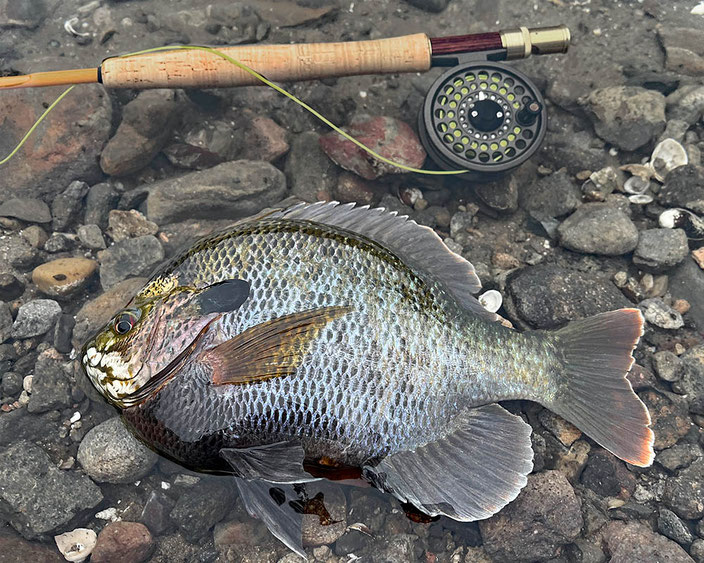Text and images by Craig Smith
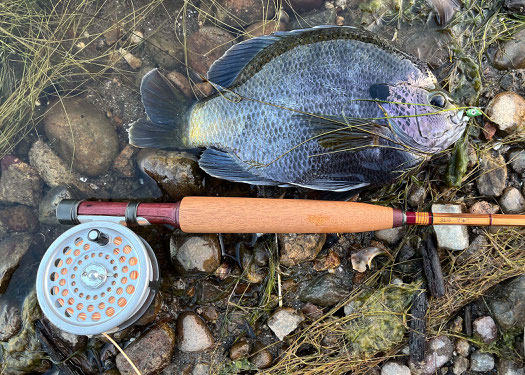
For many American anglers bluegill are the first fish they catch, often at a young age, whether it be with fly fishing gear or with other types of gear. However, many older or more love to target bluegill, even if they are in that habit of chasing species like trout, bass, tarpon, bonefish, tuna, travally, salmon, carp and a host of other species. In the San Diego area we are blessed excellent bluegill fly fishing opportunities. Our lakes are drinking water reservoirs created by blocking canyons with dams. Changing water levels and canyon topography create fisheries that are different than bluegill anglers in many other parts of the country are accustomed too. But the environment suits the fish and we can pursue them year round.
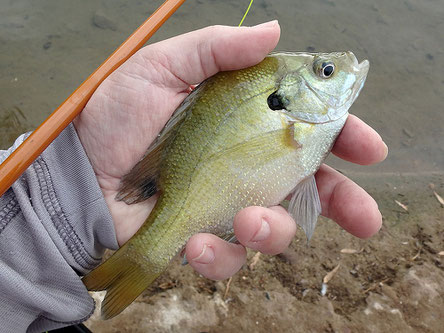
All of the lakes in San Diego County which are open to the public for fishing have bluegill populations as do many private ponds in rural areas. Even many of the mostly seasonal lower altitude streams and creeks, many of which support difficult to access pools of water year-round, contain bluegill as well as largemouth bass or green sunfish. Catchable bluegill in the 5 to 8 inch size in most local waters and many local lakes have good numbers of 10 to 12 inch long fish and even larger dinner plate sized specimens that weigh over 2 lbs are found in some of the local lakes. The largest documented bluegill caught in San Diego Country was a 3 lb 8 oz specimen from Lower Otay Reservoir captured in 1991(we have replica mold of that fish on the wall in the shop).

The first thing we need to do if we are going to target bluegill is to get some gear and flies. Neither need to be particularly fancy or pricey. If you have a setup for trout, you already have a setup for bluegill. Fly rods ranging from 0wt through 7wt are most appropriate. The 9 foot 4, 5, or 6 weight rod that most fly anglers start with for trout are great tools to start with and may be all you ever need. For some areas where casting room is limited a shorter rod is often useful. I use a 6’6” rod in a few places but 7’6” rods are usually the first my first alternate to a 9 footer for brushy creeks or lakes where the water has risen and there are lots of trees and brush very close to the banks. Rods lighter than a 4wt are often fun to use and can make even palm sized bluegill feel like a good sized fish, yet still have a enough backbone to deal with a dinner plate sized 2lb+ bluegill or a larger bass. A 7 weight rod is usually a bit heavier than needed for targeting bluegill but at times can be useful for casting larger deer hair bugs and poppers in waters with big bluegills and largemouth bass found in the same areas at the same time. Rod designs of graphite, fiberglass, and bamboo are all fine tools for chasing bluegills. Bluegill are fairly strong fish for their size but don’t make long and fast runs. Just about any fly reel that will hold a fly line will suffice, even a simple design with a fixed tension click drag.
For most bluegill angling a floating fly line will be the best option. Either a weight forward (WF) or double taper (DT) design will suffice. Most bluegill fishing targets areas within 40 feet of the angler so the differences between a WF or DT line is negligible to non-existent. If I know I will be fishing at close distances like 20 feet or less in areas where I cannot execute a normal overhead back cast, I will use a line size one or even two weights heavier than the rod’s rating, especially when I expect that I will be mostly roll casting. The heavier line will help load the rod and cast air resistant poppers when I can’t get the full head of the line outside the rod tip. Using a heavier line can be helpful, but it is not a requirement for success.
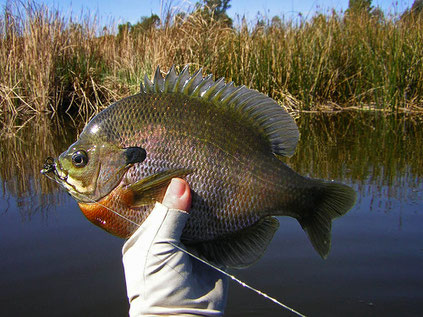
Sometimes we want to get more than 4 feet or so below the surface. An add on sinking leader, such as a Rio Trout Versileader, with a couple of feet of tippet material attached to the end can be looped to your floating line. These are convenient to use and save some funds compared to purchasing a sink tip or sinking fly line along with another reel or spare spool for the reel you already have. A sink tip fly line with a 10 to 12 foot sink tip will be useful when you want to in deeper water greater than 8 feet deep consistently. If you need to get even deeper an integrated shooting taper line with at fast sinking tip (examples: Rio Avid, 24ft Sink Tip, Rio Outbound Short, Scientific Anglers Titan Taper, Scientific Anglers Sonar 25 ft sink tip) becomes useful. These faster sinking lines won’t be needed on most waters. But some local waters, like San Vicente Reservoir often have large bluegill hold in water at depths of 15 to 20 feet along steep sloping banks. Also, on many local lakes, bluegill will retreat into deeper waters during winter months. There are multiple options for fly lines from floating to various sinking tips, but for many anglers a floating line will be all they ever need for chasing bluegills.
Leaders and tippet for bluegills don’t need to be fancy. For casting small poppers and foam bugs often used for bluegill a standard trout leader 7.5’ in length and tapering to 3x is fine. This will turn over most size 10 or 12 poppers as well as weighted woolly buggers and other subsurface patterns. A 3x leader usually has enough abrasion resistance to fish around rocks and flooded brush. If fishing small subsurface flies around weed beds a 4X leader is often just fine. When fishing subsurface flies with a 9 foot rod I will often use a 9 foot leader. This will allow me to fish a bit deeper if necessary without using a sinking Versileader or a sink tip line. Bluegill are usually not leader shy except in the clearest water so even heavier leaders tapering to 2X or 1X may be appropriate in waters with lots of subsurface structure your leader may get dragged over. If you are fishing with a sink tip or sinking line you can skip the tapered leader and just use 3 or 4 feet of 6 to 10 pound test nylon or fluorocarbon monofilament looped to your fly line.

Fly selection for bluegills can be pretty basic. Small poppers on size 8, 10, and 12 hooks are a lot fun to use when the fish are inclined to take surface offerings. This might be all the time on some waters or during limited times of the year or even day on other waters. Many of the poppers that are commercially available have rubber legs. Small bluegill will often grab these and pull the fly around rather than try to eat the entire popper at once. I often cut the legs off, but they may sometimes be necessary to seduce an otherwise reticent fish into taking your popper. The classic foam bluegill spider pattern is another great fly for when bluegills are taking food from the surface. Common dry fly patterns designed for trout such as the humpy, parachute ant, Chernobyl ant, hoppers, stimulators and others also work.
I love the “slurp” or “splat” sounds that bluegills make when they aggressively take poppers and other patterns on the surface but more than 80% of my bluegill catches are taken with subsurface patterns. Size 8, 10 and 12 wooly buggers in various colors, with or without a bead head, are great producers. So are leech patterns. When in doubt as to color, black or olive are good to try. Most nymph patterns designed for trout will work for bluegills. A size 10 Gold Ribbed Hare’s Ear, Zug Bug, or Prince nymph will catch a lot of bluegills as will most stonefly patterns. Smaller fish feed primarily on aquatic insects, plankton, vegetation, fish eggs, fish fry, and tiny crustaceans. As bluegills get larger they will increase their intake of small fish if present. I have encountered large to extra large bluegill mixed in with bass chasing threadfin shad in the pelagic areas of local lakes. White and grey woolly buggers are good to have on hand as well as classic streamers like the Mickey Finn. A size 8 grey and white or olive and white Clouser Deep Minnow can be useful to have in your box when fishing waters with threadfin shad. Size 8 Clouser Minnows are difficult to find from commercial sources so I tie my own; but, I have caught bluegills on commonly available size 6 flies.
Larger bluegill are often more selective than smaller specimens, to the point of being very selective at times. I have watched 10” long bluegill positioned with their nose less than an inch under a popper for minutes while inspecting it only to turn away, or have a smaller fish dash in and snatch up the fly while the larger fish is completing its inspection. I have also observed large bluegill follow very close behind buggers and nymphs being retrieved. Sometimes changing from a popper to a nymph, or a woolly bugger to a sparser leech or nymph pattern may get the grab. While a large selection of patterns is not needed, it useful to carry a half a dozen or so different patterns with different profiles in two or three colors. For topwater patterns I don’t find the color to be of much importance to the fish. They will be looking up against the backlight of the sky and see a mostly dark pattern. For poppers, deer hair, bugs, and foam spiders I like colors that I can see like white or yellow, or at least have white, yellow, or other bright markings that I can see in low light conditions.
The bluegill fishing in San Diego County tends to be best from March though October or mid-November. The lower elevation lakes warm up faster and the bite turns on earlier. Higher altitude lakes like Lake Cuyamaca warm up later and cool down sooner. Bluegill tend to be shallower in the warmer times of the year and during low light conditions. During the winter they retreat to deeper water that may be warmer than the surface layer if they can. During warmer times of the year they will be shallow early and late in the day, retreating to deeper water or shaded cover as the sun gets higher. Mid-day fishing in shallow water tends to produce smaller bluegills that haven’t learned to survive predation from birds yet; but, larger fish can be found tucked into shaded pockets in cattails, under docks or fallen trees, under aquatic vegetation, or in open water areas over bottom structure such as rock piles and flooded trees and brush.
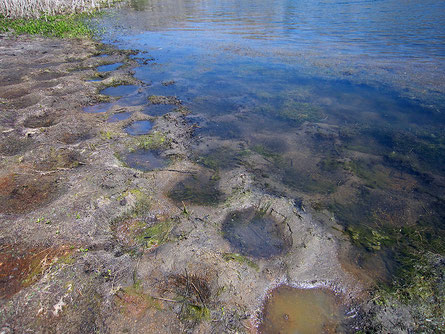
Some of the fastest action for bluegills occurs when they are spawning. Locally, spawning activity tends to occur when water temperature reaches around 65 degrees F but this may vary some in different bodies of water. In our local waters spawning activity may start to occur as early as mid-April in some waters or as late as Memorial Day in others. Fish may spawn multiple times through late summer and early fall but peak spawning activity locally usually occurs with the first cycle in late spring. Male bluegill are very protective of their nests and will aggressively attack any fly that comes close. Bluegill spawning beds can be discerned by the saucer shaped depressions in flat areas that can often be seen in shallow clear water. In water with less visibility these beds may be revealed as slightly light-colored patches on the bottom. Bed groupings or colonies can consist of a hand full of individuals or if conditions are right, groupings of hundreds of beds. The largest bluegill tend to spawn at deeper than smaller, younger fish; but, due to their aggressiveness these larger bluegill tend to be caught by casual anglers most often during the late spring spawning period. Experienced bluegill anglers can find the larger fish throughout the year.
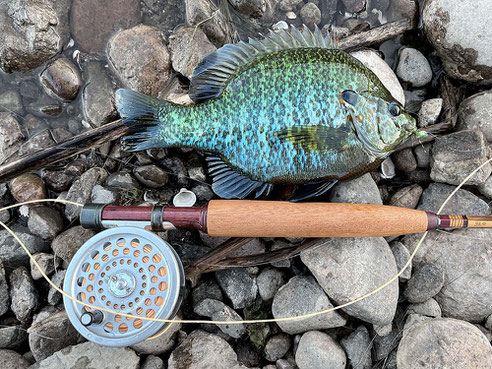
When targeting bluegill it is fairly common to encounter other species in our local waters, which can lead to some exciting surprises. Largemouth bass are in all of the local lakes as well as many ponds and the pools in seasonal creeks. Even carp, channel catfish, bullhead, redear sunfish, green sunfish, and black crappie may be caught when targeting bluegill.
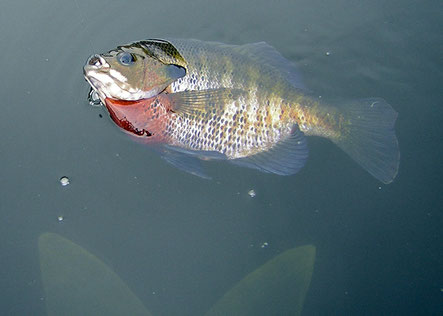
Customers often ask us where the best bluegill fishing can be found in San Diego County. As mentioned earlier, all publicly accessible lakes in San Diego County have bluegill. Populations and average size of the fish can rise and fall across years. Lower Otay, Hodges, El Capitan, San Vicente, and Barret reservoirs are known for a having consistent year to year quality size and numbers angling for bluegill, including large specimens in the 10 to 12 inch range and occasionally larger up to 2lb size. However, other lakes should not be skipped and it is worth going to any water that is convenient. Shoreline access can be difficult at many lakes due to the topography and changing water levels. A boat, kayak, or float tube will provide the most flexibility for reaching productive areas including shorelines covered with cattails. Lakes with the best access for anglers on foot include Santee Lakes #5, Sweetwater, Murray, Morena, Henshaw, and Cuyamaca (which may be waded when wearing waders and boots). Since most of the local lakes have have ample population of bluegills it doesn't hurt to keep a few for the frying pan.
